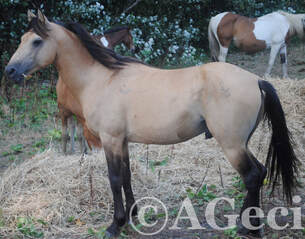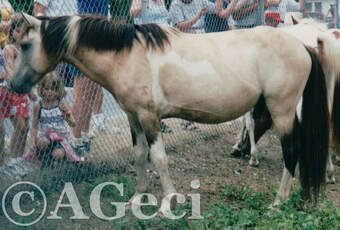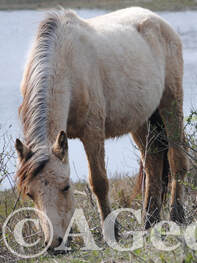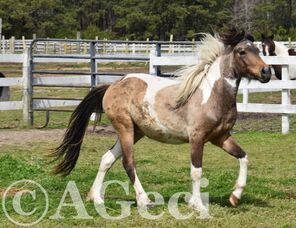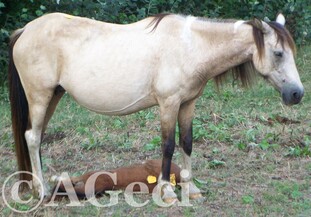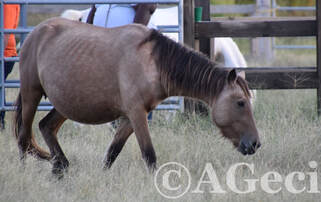Buckskin is one copy of the cream dilution (CR) on bay or brown. Cream+Bay/Brown=Buckskin.
Cream lightens the body on buckskins to a golden brown. Cream only dilutes red and has no effect on black hair so buckskins have black legs and black manes and tails.
The black on buckskins can fade in the sun so they are not completely black. Buckskins have dark skin and dark eyes. They will have black around the rims of their ears. Buckskin pinto ponies are occasionally referred to as being tri-colored.
Buckskins can have white streaks mixed into their black manes and/or tails. This is called frosting.
Cream lightens the body on buckskins to a golden brown. Cream only dilutes red and has no effect on black hair so buckskins have black legs and black manes and tails.
The black on buckskins can fade in the sun so they are not completely black. Buckskins have dark skin and dark eyes. They will have black around the rims of their ears. Buckskin pinto ponies are occasionally referred to as being tri-colored.
Buckskins can have white streaks mixed into their black manes and/or tails. This is called frosting.
In order to get a buckskin foal at least one parent must have the cream dilution. It can be any of them buckskin, palomino, smoky black, or a double dilute. At least one parent must also have bay or black. Bay/black is dominant so a pony either has it or it doesn't. A bay, chestnut, or a black that has a buckskin parent (or a lot of them in their pedigree) does not make them any more likely to produce buckskin offspring. A pony either has cream or it doesn't.
Buckskin and dun are sometimes used interchangeably or mistaken for one another. From a genetics standpoint this is incorrect as they are two different dilutions. A buckskin with a dorsal stripe or other primitive markings does not necessarily mean that it is a dun as Non-Dun1 can cause them. Dun is not found in Chincoteague Ponies.
|
Buckskin tobiano. Many of the dilutes on Assateague descend from him. Carried recessive chestnut.
Tornado (Lighthouse x White Hills) Pedigree |
|
Buckskin with frosting in winter coat. Carries recessive chestnut.
Sunrise Ocean Tides (Little Dolphin x Jessica's Sea Star Sandy) Pedigree |
|
Buckskin tobiano. Tested homozygous for black.
Ace's Tidewater Promise (Ace's Black Tie Affair x Tidewater Treasure) Pedigree |
|
Buckskin minimal tobiano. Carried recessive chestnut.
Merry Teapot's High Bid (Gunner's Moon x Sweet Mischief) Pedigree |
|
Solid buckskin. Carries recessive chestnut from sire.
Liz's Serenity (Wild Bill x Landrie's Georgia Peach) Pedigree |
|
Solid buckskin with mane frosting. Carries recessive chestnut from dam.
Anne Bonny's Little Flower (Tornado's Legacy x Anne Bonny) Pedigree |

